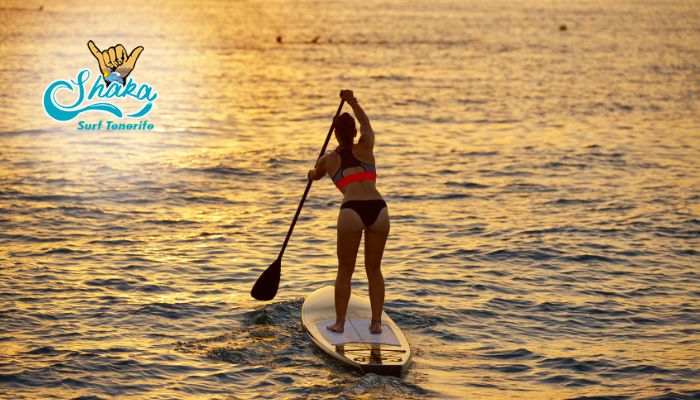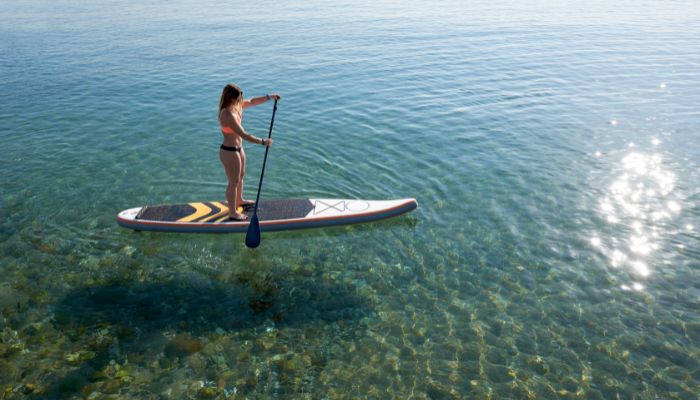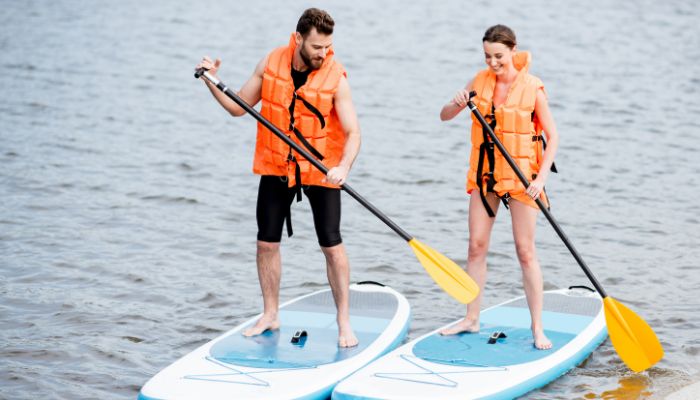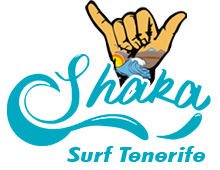
What is paddleboarding?
You might be wondering what paddleboarding, SUP (Stand Up Paddle), or stand-up paddleboarding actually is — and it’s a more common question than you might think. First things first: it’s far more than just a sport. It’s a way of exploring the water from a completely different perspective, combining balance, movement, and a deep connection with nature.
Born on the beaches of Hawaii as a technique for getting around and observing the ocean, this activity has evolved into one of the most accessible and popular water sports in Tenerife — and across Spain.
Sounds intriguing, doesn’t it? With just a board and a paddle, you can enjoy unique moments on the water, whether at sea, on rivers, or in reservoirs. Curious about how it works, where it comes from, or who can try it? Read on.
What Is Paddleboarding and Where Did It Come From?
Paddleboarding, or Stand Up Paddle (SUP), is an activity you’ve probably seen people doing on beaches, rivers, or lakes: standing on a large board, gently paddling — or sometimes taking on a few waves.
But there’s more to it than meets the eye. It’s a sport that blends connection with the water, balance, and the freedom to explore landscapes from a totally different angle.
So, how did it all begin?
The truth is, this sport isn’t some modern invention, even if its recent boom in Spain and other countries might make it seem that way.
It’s believed that the first people to stand and paddle on boards were the ancient Polynesians, who used this technique to travel between islands or fish.
They used hand-carved wooden boards and long paddles, connecting with the ocean in a way that still inspires us today.
However, paddleboarding as we know it today took shape in Hawaii — the spiritual home of surfing. In the 1950s, Waikiki surf instructors began standing on large surfboards and paddling to get a better view of their students and the waves.
Despite these practical beginnings, SUP didn’t really become popular as a sport until the early 2000s, when professional surfers started using it to stay in shape on days without waves.
Since then, paddleboarding has spread rapidly around the world.
In Spain, the sport has found the perfect environment to thrive. With its spectacular coastline stretching from the Mediterranean to the Atlantic — and its rivers and scenic reservoirs — there’s something for every taste.
Its popularity has grown largely thanks to how easy it is to get started. Unlike traditional surfing, you don’t need waves or previous experience. Calm water, a board, and a paddle are all it takes.

More Than Fun — The Benefits of Paddleboarding
Paddleboarding isn’t just enjoyable — it brings plenty of physical and mental benefits. Here are some of the main ones:
Improves balance
- Staying upright on the board while paddling strengthens your sense of balance.
- It engages key core muscles (abs, back, and hips) to keep you steady.
Full-body workout
- Every paddle stroke works your arms, shoulders, and chest.
- Your legs and glutes are constantly engaged to keep you balanced.
- It’s a full-body workout, but gentle and low-impact on your joints.
Better posture and reduced back pain
- By strengthening your core and back, it naturally improves your posture.
- It helps prevent muscular aches caused by a sedentary lifestyle.
Reduces stress and clears the mind
- Being on the water and surrounded by nature has an almost instant calming effect.
- It’s the perfect opportunity to switch off and enjoy the moment.
Who Can Practise Paddleboarding?
Almost anyone can enjoy paddleboarding, regardless of age, experience, or fitness level. It’s an activity that can be adapted to suit:
Children and teens
Paddleboarding is a brilliant activity for youngsters. With boards tailored to their size and weight, they can learn safely while building confidence, balance, and coordination. And because it’s fun and engaging, they won’t even notice they’re exercising!
Adults of all ages
Whether you’re an active person looking for a new challenge or someone who prefers relaxing activities in nature, SUP has something for you.
You don’t need to be super fit to start. You can also adjust the intensity — from a gentle paddle on calm water to more demanding sessions with waves.
Older adults
Yes — paddleboarding is ideal for those who want to stay active in a safe and gentle way. It’s low-impact and easy on the joints, helping to strengthen muscles without the risk of injury.
Spending time on the water also has a therapeutic effect, improving mood and overall well-being.
Athletes looking for variety
If you already practise other sports and are looking for something new to train your body holistically, SUP is a great option.
Surfers, runners, and even yoga practitioners use paddleboarding to improve balance, strength, and endurance.
Beginners with no experience in water sports
Even if you’ve never done a water sport before, paddleboarding is a fantastic place to start. It’s easy to learn, and if you begin in calm water, it’s a safe and quick adaptation process.

What Do You Need to Start Paddleboarding in Tenerife?
Thinking of giving paddleboarding a go? Great idea — and doing it in a place like Tenerife makes it even better.
This island is perfect for it: crystal-clear waters, mild weather year-round, and stunning scenery.
To get properly prepared and make the most of the experience, here’s what you’ll need:
1. Basic Paddleboarding Gear
To start out, you’ll need a few essentials to enjoy the sport safely and comfortably:
- SUP board: Wider, more stable boards are ideal for beginners as they’re easier to balance on. If you’re renting equipment, our school Shaka Surf offers boards suited to your weight and skill level.
- Paddle: Should be lightweight and height-adjustable for comfortable use. Learn how to hold it properly to maximise efficiency and avoid strain.
- Leash (safety cord): This attaches your ankle or calf to the board, preventing it from drifting away if you fall. Essential for safety.
- Buoyancy aid: While Tenerife’s waters are generally calm, wearing a buoyancy vest is a good idea, especially if you’re new to the sport.
- Wetsuit (optional): Depending on the season, Tenerife’s waters can be a bit cool — a wetsuit helps keep you warm and comfortable.
2. Lessons and Professional Guidance
If it’s your first time, we highly recommend starting with our SUP lessons in Tenerife. We’ll help you learn the basics quickly and build your confidence. Our school offers:
- Lessons for all levels: Learn how to keep your balance, paddle efficiently, and get on the board with ease.
- Water safety tips: Understand local sea conditions and how to respond to currents or wind changes.
- Guided routes: At Shaka Surf, we organise SUP excursions to some of the island’s most stunning spots — like sea caves near Los Cristianos beach and breathtaking volcanic cliffs.
3. Know the Sea Conditions
Before heading out, always check the weather and sea conditions:
- Wind: Avoid windy days, as it makes paddling and balance harder.
- Currents: Ask about local currents and always follow advice from lifeguards or locals.
- Tides: Tidal movement can affect ease and safety — make sure you’re aware.
4. Hydration and Sun Protection
Tenerife gets plenty of sunshine, so don’t forget:
- Water-resistant suncream
- A hat or cap
- Water — paddling can be more tiring than it looks!

